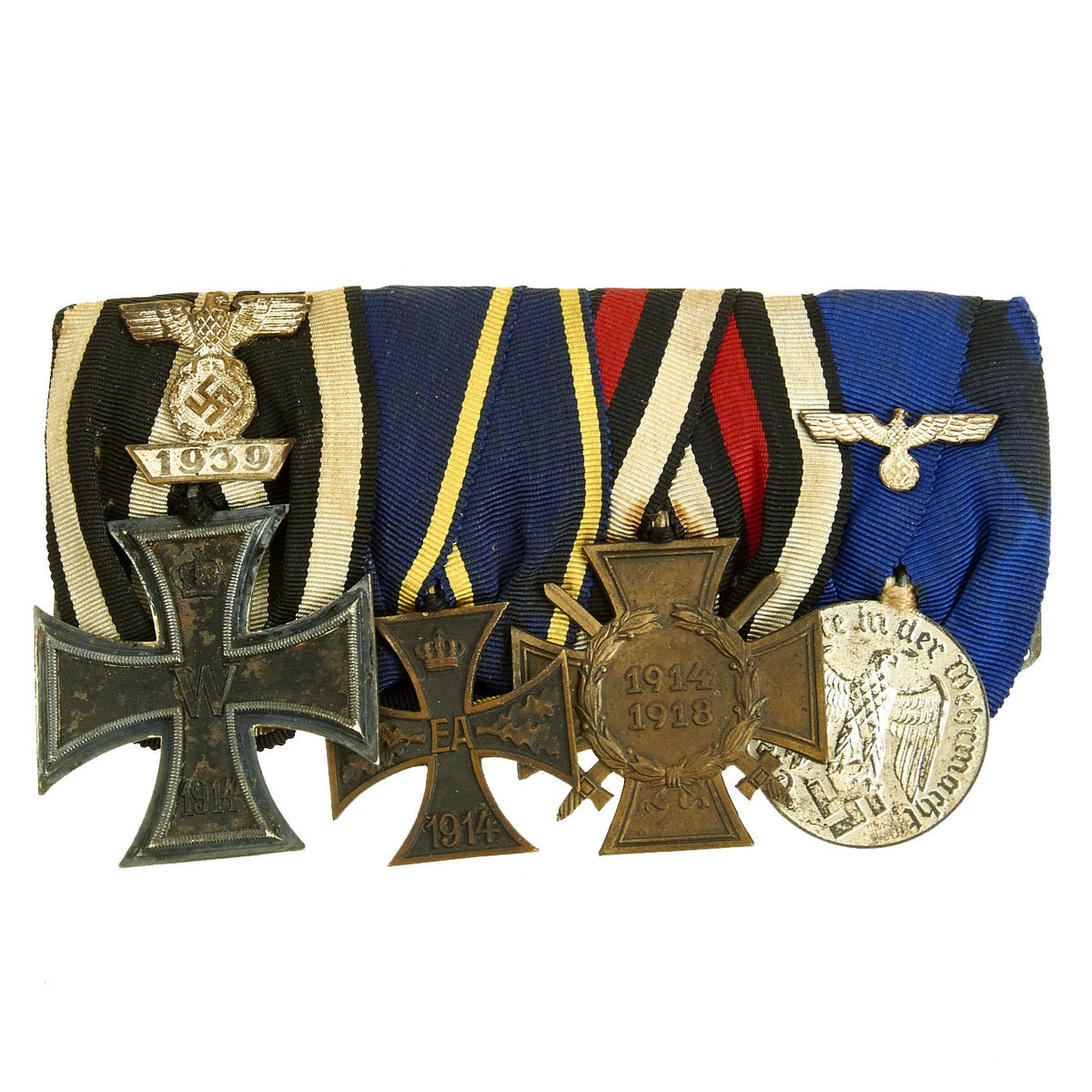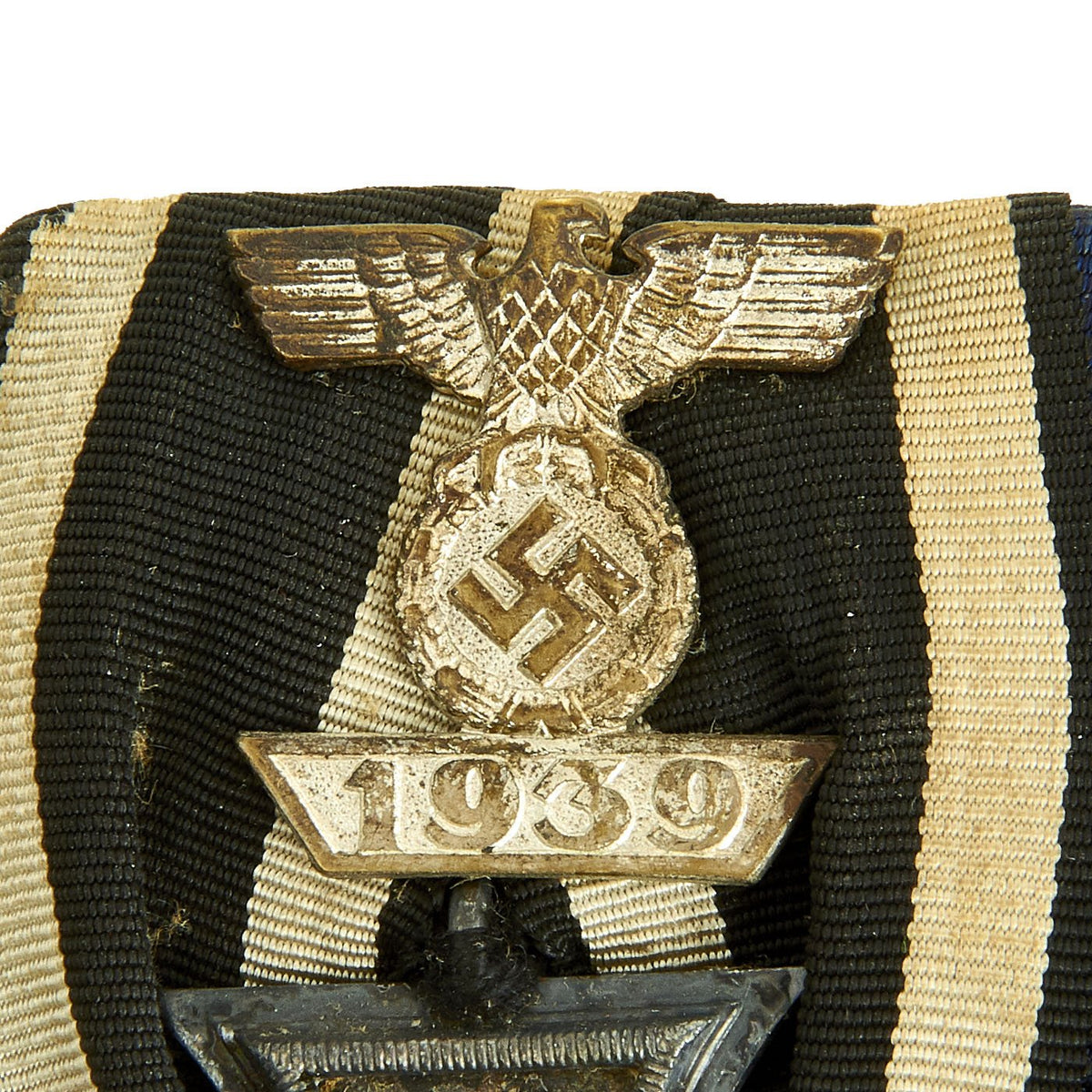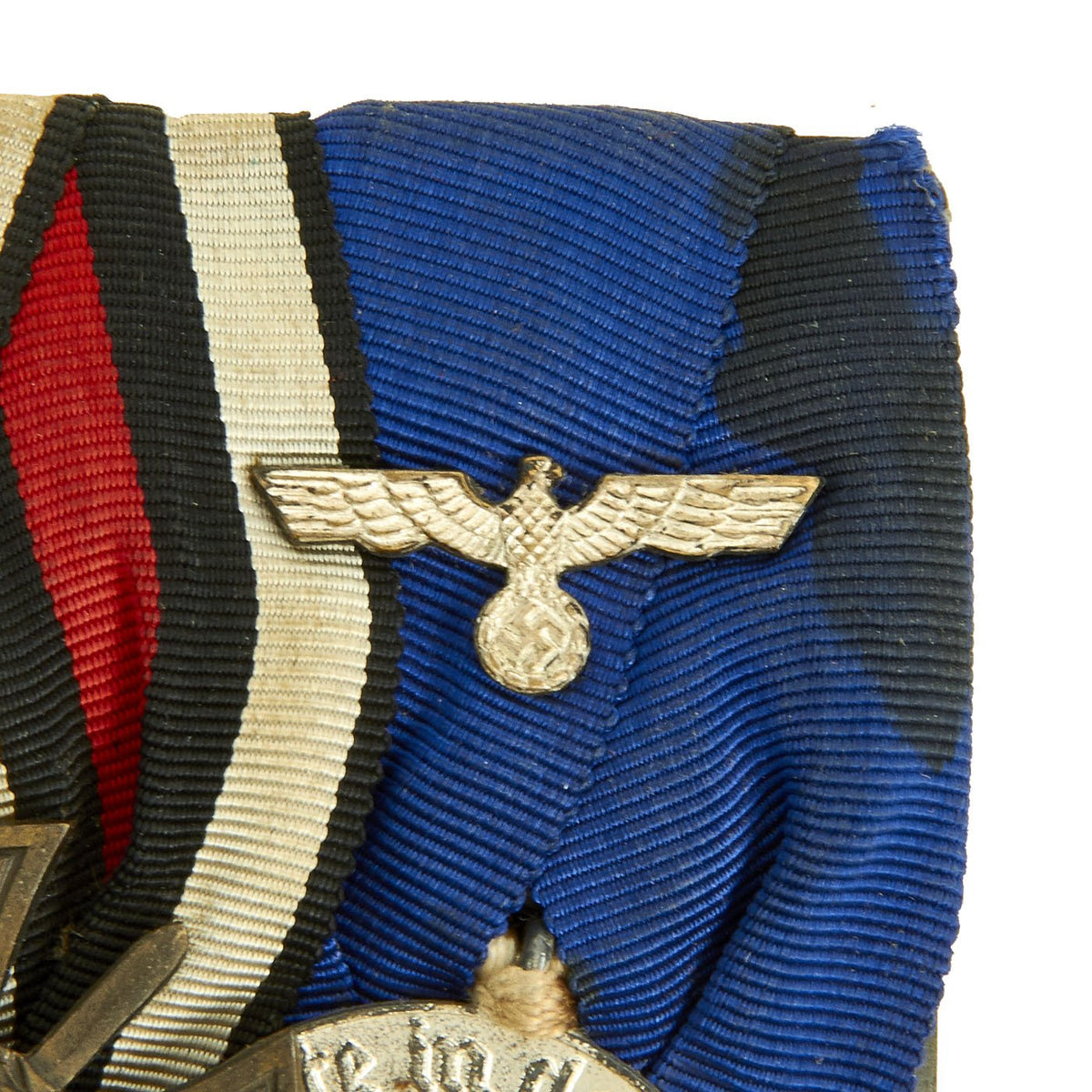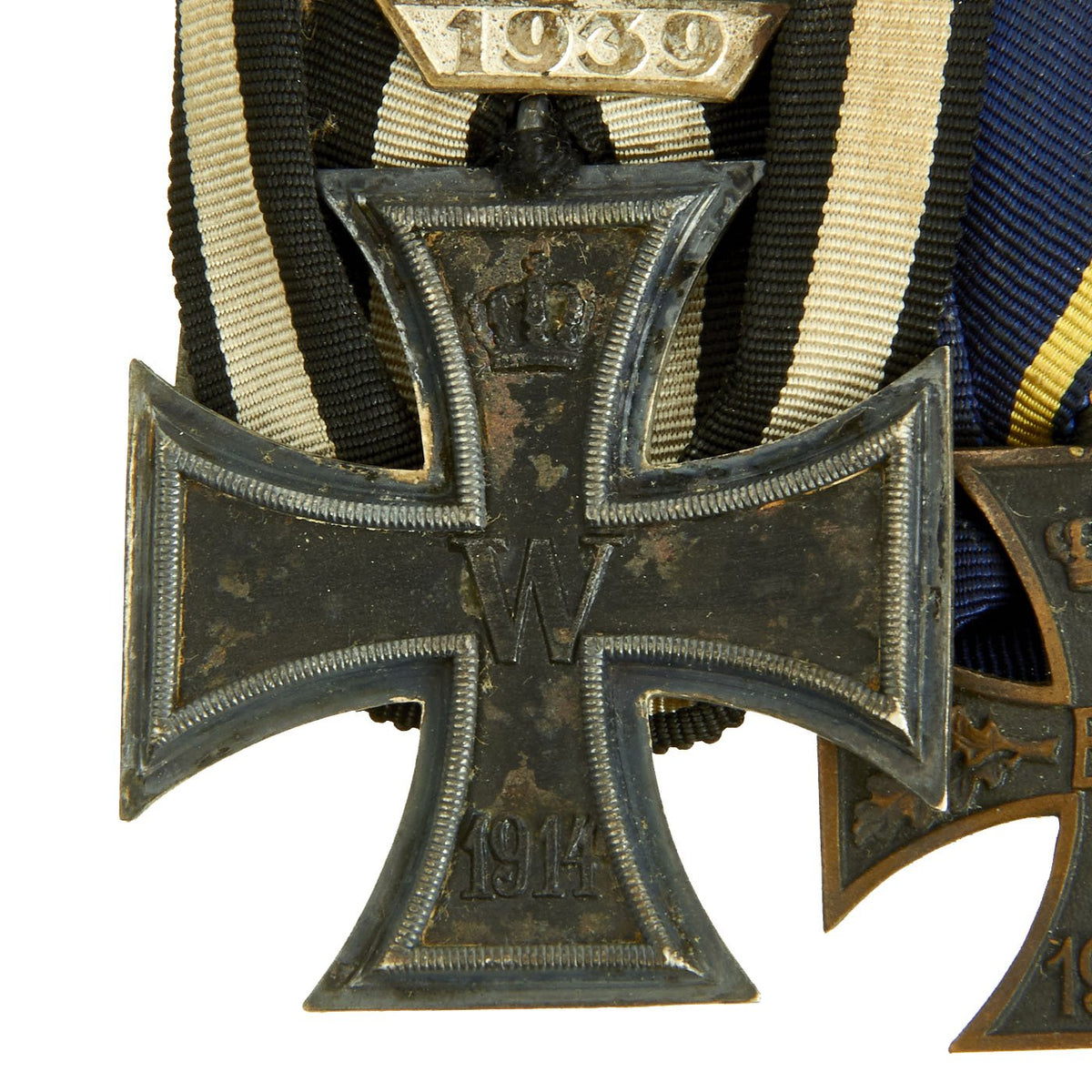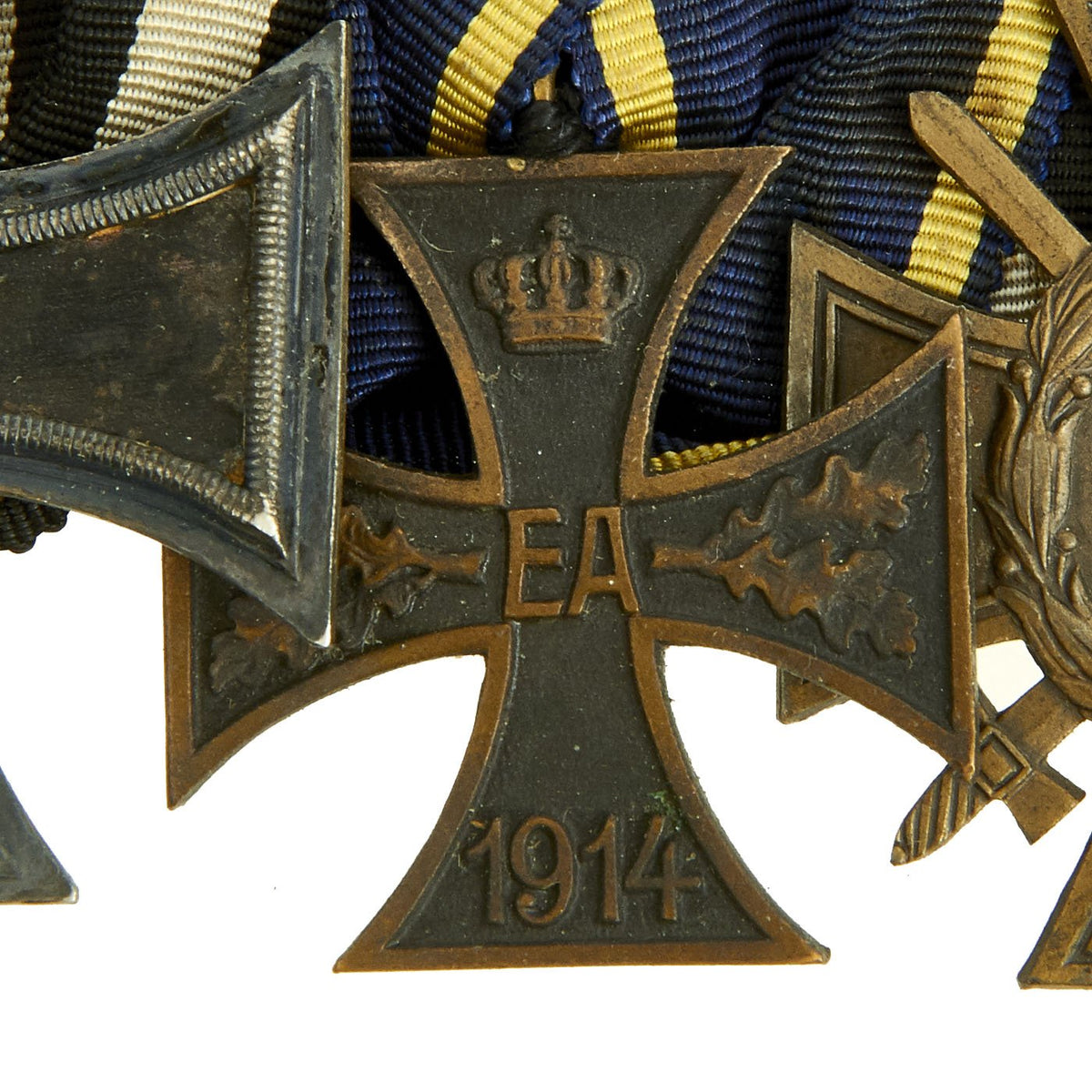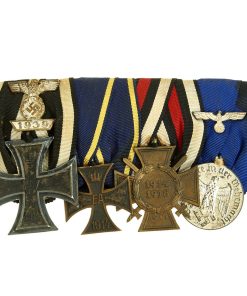Original German WWI / WWII Era Medal Bar with EKII and Brunswick War Merit Cross – 4 Awards Original Items
$ 495,00 $ 148,50
Original Item: One-of-a-kind. This is a very nice genuine medal bar, owned by a German soldier who fought during WWI, and was apparently from the Duchy of Brunswick (Braunschweig). He then served again during WWII, earning additional decorations. The colors on some of the ribbons are slightly due to wear and age, but it is still a very attractive piece.
The set of 4 medals offered in good condition is mounted on a metal backing board with pin and lined with field gray wool felt (unfortunately moth damaged) and consists of the following medals:
– Imperial German WWI Iron Cross 1914 2nd Class Medal, fitted with the Clasp to the Iron Cross 1939, for an additional award earned during WWII.
– WWI Duchy of Brunswick War Merit Cross 2nd Class – Ernst-Augustkreuz
– German WWI Honor Cross of the World War 1914/1918 (Hindenburg Cross) Medal
– German WWII Wehrmacht 4th Class Long Service Award (Silver) – 4 Years
Below is an explanation of each medal in detail:
German WWI Prussian Iron Cross 2nd Class with Ribbon:
Established by Frederick William in 1813 for gallantry in action, the Eisernes Kreuz (EK) decoration was revived several times for later conflicts. The bulk of the issues are divided into 1st and 2nd class versions, but a rare and superior ‘Grand Cross’ was also awarded for successful field commanders. During WW1 the lower decoration was freely awarded with 5½ million second class types issued. Originally, the Iron Cross was an award of the Kingdom of Prussia, however given Prussia’s pre-eminent place in the German Empire formed in 1871, it became an award for all of Germany.
The basic design of the WW1 crosses is a central cross patee struck from iron and mounted in a silver frame which has a raised crenulated decorative border. The obverse of the cross bears the date 1914 under a crowned ‘W’ monogram. Reverse bears an oak leaf cluster with the date of the decoration’s institution, 1813 underneath – the crowned initials of Frederick William are in the top arm above the oak leaf cluster. Suspension for second-class types is by means of a ring, and frequently this ring bears a maker’s stamp.
Please examine the edge seam for authentication, which is not present on reproductions. Iron crosses were commonly constructed from an iron core sandwiched in a surrounding two part silver frame, normally the seam of these two silver parts is visible around the edge of the cross as is seen on this fine example.
With so many Iron Crosses issued in WWI, it was inevitable that soldiers who already had achieved the 1914 version of the award might receive another during WWII. When the 1939 Iron Cross began being issued, they also introduced the Clasp to the Iron Cross (Spange zum Eisernen Kreuz). This way, a holder of the 1914 Iron Cross could be awarded a second or higher grade of the 1939 Iron Cross. To permit the two medals to be worn together, a “1939 Clasp” (Spange) would be worn on the original 1914 Iron Cross. It depicted a national eagle clutching an oak leaf wreath surrounding a swas above a trapezoid bearing the year 1939.
The Brunswick War Merit Cross
Known in German as the Braunschweigisches Kriegsverdienstkreuz or Ernst-Augustkreuz (Ernst-August Cross), this was a military decoration of the Duchy of Brunswick. The Cross was established 23 October 1914 by Ernest Augustus, Duke of Brunswick. The cross was awarded to all ranks for distinction in war. On 20 March 1918, a first class of the Cross was created in pinback form, with the existing Cross becoming the second class. This brought the Cross in line with awards of other German States like Prussia with the Iron Cross. The cross was awarded on a blue ribbon with yellow stripes for combatants and on a yellow ribbon with blue stripes for non-combatants.
The Brunswick War Merit Cross is a bronze cross pattée. At the center of the Cross on the obverse are the letters EA for Duke Ernest Augustus. On the horizontal arms of the cross are sprays of oak leaves. The top arm of the cross bears the Brunswick crown, with the date 1914 on the lower arm of the cross. On the reverse is the inscription in three lines Für / Verdienst im / Kriege (For Merit in War) on the top, horizontal and lower arms of the cross, respectively.
Hindenburg Cross with Crossed Swords (for combat):
The Honor Cross of the World War 1914/1918 (German: Das Ehrenkreuz des Weltkriegs 1914/1918), commonly, but incorrectly, known as the Hindenburg Cross was established by Field Marshal Paul von Hindenburg, President of the German Republic, by an order dated 13 July 1934, to commemorate the distinguished deeds of the German people during the First World War. This was Germany’s first official service medal for soldiers of Imperial Germany who had taken part in the war, and where they had since died it was also awarded to their surviving next-of-kin. Shortly after its issuance, the government of NSDAP Germany declared the award as the only official service decoration of the First World War and further forbid the continued wearing of German Free Corps awards on any military or paramilitary uniform of a state or NSDAP Party organization.
This example is marked on the back with G. & S.
Wehrmacht Long Service Award – 4 Years:
This award was a military service decoration of NSDAP Germany issued for satisfactory completion of a number of years in military service. The award itself is cumulative, so after the 3rd class, both a cross and a medal were worn, and the color indicated service.
On 16 March, 1936, Adolf AH ordered the institution of service awards for the first four classes, each reflecting the completion of a select number of years of military service.
Each branch of the Wehrmacht (army, navy, and air force) maintained their own version of the Long Service Award and the decoration was issued for four years (silver medal – fourth class), 12 years (gold medal – third class), 18 years (silver cross – second class), 25 years (gold cross – first class), and 40 years (1939 special class). The 40 years special class service award was introduced on 10 March 1939.
Professor Dr Richard Klein designed the awards. Recipients of lower year awards would wear the decoration simultaneously with higher level decorations. The manner they could be worn was:
3rd Class with 4th Class (gold medal with silver medal)
2nd Class with 4th Class (silver cross with silver medal)
1st Class with 3rd Class (gold cross with gold medal)
The Long Service Award was retroactive throughout a service member’s career, encompassing Reichswehr service as well as service dating during and before World War I. As such, there were a handful of 40 year awards presented, even though the NSDAP era only lasted 12 years (1933-1945).
Fast Shipping with Professional Packaging
Thanks to our longstanding association with UPS FedEx DHL, and other major international carriers, we are able to provide a range of shipping options. Our warehouse staff is expertly trained and will wrap your products according to our exact and precise specifications. Prior to shipping, your goods will be thoroughly examined and securely secured. We ship to thousands clients each day across multiple countries. This shows how we're dedicated to be the largest retailer on the internet. Warehouses and distribution centres can be located throughout Europe as well as the USA.
Note: Orders with more than one item will be assigned a processing date depending on the item.
Before shipping before shipping, we'll conduct a thorough inspection of the items you have ordered. Today, the majority of orders will be delivered within 48 hours. The delivery time will be between 3-7 days.
Returns
The stock is dynamic and we cannot completely manage it because multiple stakeholders are involved, including our factory and warehouse. So the actual stock may alter at any time. It's possible that you may not receive your order once the order has been made.
Our policy is valid for a period of 30 days. If you don't receive the product within 30 days, we are not able to issue a refund or an exchange.
You can only return an item if it is unused and in the same state as the day you received it. You must have the item in its original packaging.
Related products
Uncategorized
Uncategorized
Uncategorized
Uncategorized
Uncategorized
Uncategorized
Angolan Rebel 1970s era 60mm Inert Display Mortar from Angolan Civil War Original Items
Uncategorized
Uncategorized
Uncategorized
Uncategorized
Uncategorized
Uncategorized
Australian WWII Owen MK1 Machine Carbine SMG Custom Fabricated Replica with Sling Original Items
Uncategorized
Uncategorized
Uncategorized
Armored Burgonet Helmet & Polearm from Scottish Castle Leith Hall Circa 1700 Original Items
Uncategorized
Uncategorized
Uncategorized
Armoured Fighting Vehicles of the World: AFVs of World War One (Hardcover Book) New Made Items
Uncategorized
Uncategorized
